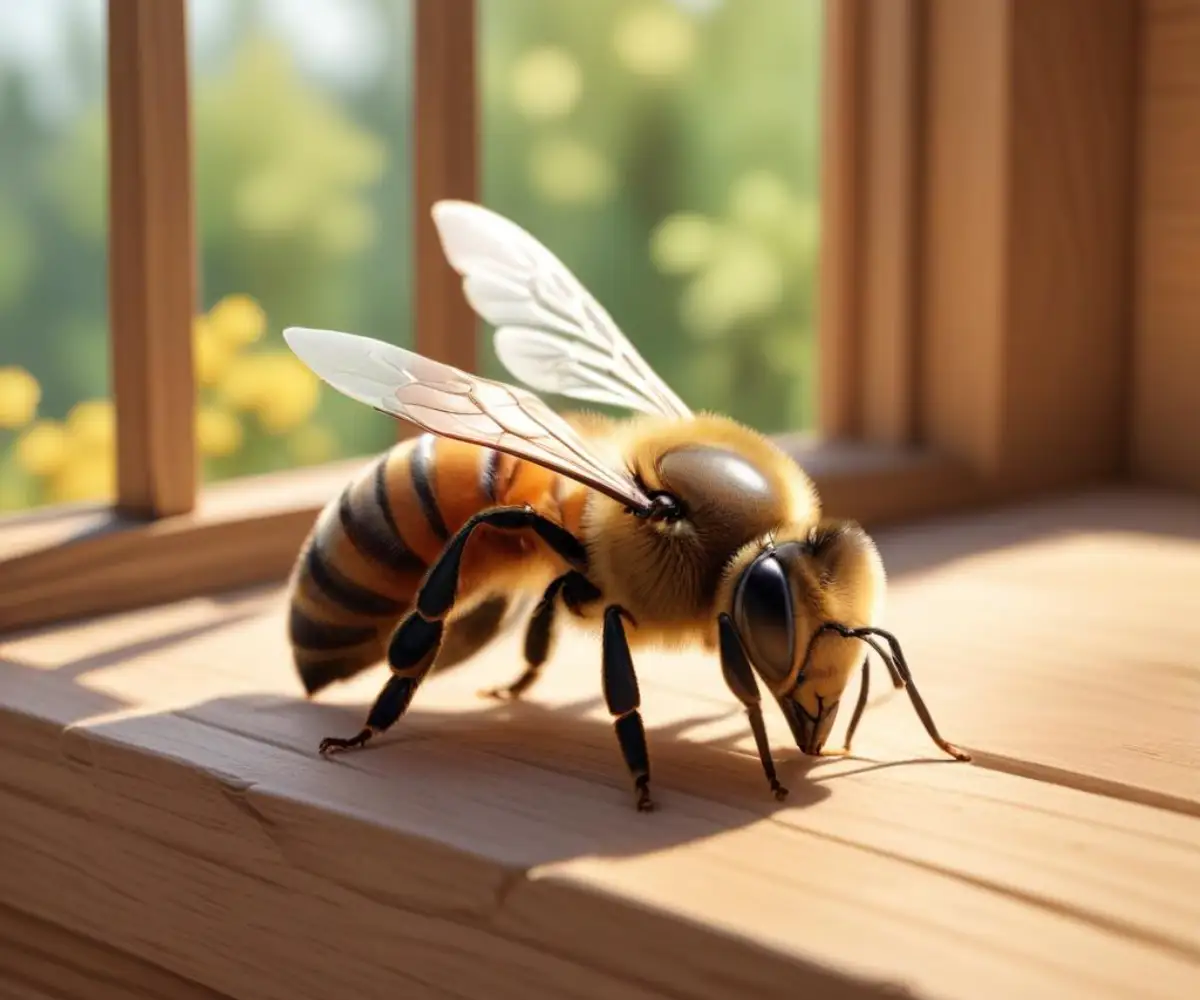Lethargic Bees in Your House? Here’s the Surprising Truth
Discovering a slow, sluggish bee on your floor or windowsill can be an unsettling experience. It’s a scene that raises immediate questions and concerns: Is it sick? Is it dying? Could it sting? And most importantly, why is it in your house?
While a single lethargic bee is usually not a cause for panic, it’s a situation that warrants understanding. This guide will walk you through the common reasons you might find a tired bee indoors and provide clear, safe, and effective steps for what to do next.
You'll Learn About
Why Are You Finding Lethargic Bees in Your House? Uncovering the Causes
Finding a slow-moving bee indoors can happen for a variety of reasons, most of which are harmless. Understanding the cause is the first step to responding appropriately and compassionately.
Natural Life Cycles and Simple Exhaustion
Many bees have remarkably short and industrious lives. A worker bee might only live for a few weeks, and during that time, it works tirelessly. Sometimes, a bee you find indoors is simply at the end of its natural lifespan and has become weak.
This is especially common with bumblebees toward the end of summer and in the fall. The colony’s life cycle is concluding, and only the new queens will survive the winter by hibernating. Older worker bees will naturally become lethargic as their life comes to an end.
Dehydration and Lack of Energy
A bee’s life is a constant search for energy in the form of nectar. A foraging bee is often only about 40 minutes away from starvation. If it gets trapped indoors or flies a long distance without finding flowers, it can simply run out of fuel.
An exhausted bee will appear slow and sluggish. It lacks the energy to fly and may crawl on the ground, seemingly dazed. This is one of the most common reasons to find a lethargic bee inside your home.
Cold Temperatures and Accidental Entry
Bees are cold-blooded and rely on external heat to warm their flight muscles. A sudden drop in temperature or getting caught in the rain can leave a bee stunned and unable to fly. It might seek refuge in the warmth of a house through an open window or door.
Often, a bee’s presence indoors is a simple mistake. It flew in through an open window, a gap in a screen, or a small crack in the building’s exterior and now can’t find its way out. Exhausted from trying to escape, it becomes lethargic.
The Overlooked Danger: Pesticide Exposure
A more serious cause of bee lethargy is exposure to pesticides. Systemic pesticides like neonicotinoids can be present in the nectar and pollen of treated plants. Even low doses don’t kill the bee outright but cause sublethal effects.
These effects include impaired navigation, disorientation, and uncoordinated movement, which can appear as lethargy. A poisoned bee may have difficulty moving, walk in circles, or have its tongue sticking out.
A Potential Sign of a Hidden Infestation
While a single lethargic bee is usually an isolated incident, finding multiple slow-moving or dead bees over several days is a red flag. This can be a sign that a colony has established a nest within your home’s walls, attic, chimney, or other voids.
Bees from an internal hive can become disoriented, especially by indoor lighting, and emerge into your living space. If you notice a recurring pattern, it’s crucial to investigate further for signs of an infestation.
First Steps: How to Safely Handle a Lethargic Bee Indoors
Before you act, it’s important to identify the insect and proceed with caution. Even a tired bee can sting if it feels threatened. Your primary goal is to handle the situation safely for both you and the bee.
Assess the Situation: Is It a Bee or a Wasp?
People often confuse bees with wasps or hornets. Correctly identifying the insect is key, as their behaviors and the appropriate responses differ. Use this table to help distinguish between them.
| Insect | Appearance | Behavior | Sting |
|---|---|---|---|
| Honeybee | Slightly fuzzy, golden-brown and black stripes. | Generally gentle, focused on foraging, not aggressive unless the hive is threatened. | Barbed stinger; stings once and then dies. |
| Bumblebee | Very fuzzy, robust, black with yellow, white, or orange bands. | Docile and gentle; rarely stings unless provoked. | Smooth stinger; can sting multiple times but is reluctant to. |
| Carpenter Bee | Looks like a large bumblebee but has a shiny, black, hairless abdomen. | Solitary; males are territorial but cannot sting. Females can sting but are not aggressive. | Females can sting multiple times but rarely do. |
| Yellow Jacket (Wasp) | Sleek, shiny body with distinct black and bright yellow markings. Not fuzzy. | Aggressive, especially near their nest. Often attracted to human food and sugary drinks. | Smooth stinger; can sting repeatedly and aggressively. |
Safety First: Protecting Yourself and Your Family
An exhausted bee is unlikely to sting, but it’s still a possibility if it feels pinned down or crushed. The safest way to handle a bee is to avoid direct contact with your hands.
The best method is the “cup and card” technique. Gently place a cup or glass over the bee. Then, slide a stiff piece of paper or cardboard underneath to trap it inside, allowing you to move it safely.
Providing First Aid: The Sugar Water Solution
If the bee appears tired and not at the end of its life (e.g., its wings are intact), you can offer it a quick energy boost. This simple act can often revive an exhausted bee in minutes.
Create a simple solution by mixing equal parts white granulated sugar and warm water. Stir until the sugar dissolves completely. Never use honey, as it can contain pathogens that are harmful to bees, and avoid brown sugar.
Place a small drop of the sugar water on a spoon or a bottle cap and put it directly in front of the bee. Be careful not to pour the liquid on the bee, as it could get stuck or drown.

The Next Steps: Helping the Bee or Dealing with a Bigger Problem?
After your initial assessment and first aid, the next step depends on whether you’re dealing with a single lost bee or the signs of a larger issue. Your actions can make a difference for both the bee and your home.
Releasing a Revived Bee
If the bee drinks the sugar water, it will likely perk up within a few minutes to an hour. Once it seems more active, it’s ready to be released. Use the cup and card method to transport it outside.
Place the bee on a nearby flower or in a sunny, sheltered spot. This gives it a safe place to finish recovering and a chance to collect natural nectar before flying off.
When to Suspect an Infestation
If you’re finding lethargic bees inside daily, it’s time to shift your focus from rescue to investigation. A hidden nest inside your home requires a different approach. Look for these key signs:
- An increased number of bees around a specific area of your home’s exterior.
- Audible buzzing sounds coming from within a wall or ceiling.
- Dark stains on your walls or ceiling, which could be honey seeping from a nest.
- Bees entering and exiting through a small crack, vent, or hole in the siding or roofline.
Professional Bee Removal vs. DIY
Under no circumstances should you attempt to remove a bee nest yourself. Attempting to block the entrance can force the bees to find another way out, which could be further inside your home. Spraying insecticides can be dangerous and may not penetrate the entire nest, leading to an angry, defensive colony.
Contact a professional beekeeper or a humane pest removal service. They have the expertise and equipment to safely remove the entire colony, including the queen and the honeycomb, preventing future problems and protecting these vital pollinators.
Prevention: How to Bee-Proof Your Home for the Future
Preventing bees from entering your home in the first place is the best long-term solution. A few simple home maintenance tasks can make a significant difference and protect both your home and the local bee population.
Seal Cracks and Gaps
The most effective way to keep bees out is to deny them entry. Walk around the exterior of your home and inspect it carefully for any potential entry points. Pay close attention to gaps around window and door frames, cracks in the foundation, and openings where utility lines enter the house.
Ensuring your home is well-sealed is a fundamental step. For instance, improving your home’s envelope with proper materials, as some homeowners do when exploring premium foam insulation, not only helps with energy efficiency but also creates a formidable barrier against pests.
Secure Windows and Doors
Check all your window and door screens for rips or holes and repair them promptly. Ensure that there are no gaps around the frames. Bees are resourceful and can squeeze through very small openings.
Also, be mindful of keeping doors and windows without screens closed, especially during peak bee activity in the spring and summer months.
Rethink Your Garden and Landscaping
You can encourage bees to thrive in your yard without inviting them into your house. Planting a variety of bee-friendly flowers can provide them with ample food sources away from your home’s entrances. Someone wondering if they can plant trees in their backyard might also consider flowering trees that support pollinators.
Avoid planting large, attractive flowerbeds directly next to doorways or patios. This strategic placement helps guide bee traffic to areas of your yard where they won’t accidentally wander indoors.
Common Questions and Concerns about Lethargic Bees
It’s natural to have questions when you encounter wildlife in your home. Here are answers to some of the most common queries about finding slow bees indoors.
Is a lethargic bee definitely dying?
Not necessarily. A bee could simply be cold, exhausted, or even resting. Providing a warm spot or a drop of sugar water can often revive a bee that isn’t at the end of its life.
Can a lethargic bee still sting me?
Yes, it is possible. While a weak bee is not aggressive, it can sting defensively if it feels threatened, such as being pressed or swatted. This is why it’s crucial to use a gentle, hands-off approach like the cup and card method for removal.
Why do I only find them in one specific room?
This often points to the bee’s entry point. The room may have an open window, a damaged screen, or a small structural gap. Sometimes, issues like minor gaps created during appliance installation, similar to the challenges faced with dishwasher height problems, can create an unseen entry route.
Does finding a bee in my house mean it’s dirty?
Absolutely not. A bee’s presence has nothing to do with cleanliness. They are attracted to shelter, warmth, and light, not dirt or grime.
A Compassionate and Practical Approach
Encountering a lethargic bee in your house is a small but important moment of intersection between our world and the natural one. In most cases, it’s a single, exhausted creature that has lost its way and needs a simple act of kindness to be sent on its way.
By assessing the situation, acting safely, and providing help when needed, you can handle the event with confidence. And by remaining vigilant for the signs of a larger problem, you can protect both your home and these indispensable pollinators.

